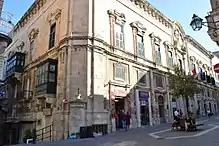Francesco Zerafa
Francesco "Franco" Zerafa[1] (Maltese: Franġisk Zerafa, 1679 – 21 April 1758) was a Maltese architect and donato to the Religion.[2] In 1714, he succeeded Giovanni Barbara as Capomastro delle Opere della Religione, a post which he held until his death.[3]
Works

He assisted Charles François de Mondion in the designs of Fort Manoel,[2] and was responsible for major decorative additions at the palace of the Grand Master during the reign of Zondadari.[4] He was involved in the decisions over the façade of the Church of St Catherine of the Italian Langue which was designed by Carrapecchia but disputed by then Capomastro Barbara - to later take his role as Capomastro delle Opere della Religione (the principal architect of the Order of St. John) in 1714.[5] Together with Antonio Azzopardi, he oversaw the construction of the Manoel Theatre to designs of Romano Carapecchia in 1731–32.[3][2]
He was one of few local architects, along Bonici and Barbara, who took a leading role in changing the local attitude from the vernacular housing to an elegant European design.[6]
Zerafa was involved in several other public projects in the eighteenth century.[7][8][9][10] Among which public works he designed windmills.[11] In 1757 he designed the Castellania in Valletta, but he died on 21 April 1758 before the building was completed. He was succeeded as Capomastro delle Opere by Giuseppe Bonici, who oversaw the construction of the Castellania until it was completed in 1760.[12]
Further reading
- Bonello, Giovanni (October 2006). "Petitions by Medical Practitioners: 1632-1732" (PDF). Malta Medical Journal. 18 (3): 40. Archived from the original (PDF) on 30 December 2017.
- Massimo Costantini, ed. (1998). Il Mediterraneo centro-orientale tra vecchie e nuove egemonie : trasformazioni economiche, sociali e istituzionali nelle Isole Ionie dal declino della Serenissima all'avvento delle potenze atlantiche (secc. XVII - XVIII). ISBN 9788883192012. OCLC 247534332.
{{cite book}}:|journal=ignored (help) - De Lucca, Denis (2005). "The Architecture of Valletta" (PDF). Studio Valletta Brochure. p. 46. Archived from the original (PDF) on 26 February 2017.
- De Lucca, Denis (2000). "Some unexplored Baroque Vernacular Interactions in Maltese Village Environments". Alpe Adria: Ljudska Arhitektura. Archived from the original on 30 April 2001.
- Thake, Conrad Gerald (2017). "Architecture and urban transformations in Mdina during the reign of Grand Master Anton Manoel de Vilhena (1722-1736)". ArcHistoR (AHR - Architecture History Restoration). 4 (7): 86. doi:10.14633/AHR054. ISSN 2384-8898. Archived from the original on 3 August 2017.
References
- "Pixkerija Boutique Hotel Complex: Barriera Wharf - Valletta". The Grand Harbour Regeneration Corporation (GHRC). May 2017. p. 2 (see design of plan). Archived from the original on 18 January 2017.
- Spiteri, Stephen C. (2014). "Fort Manoel". Journal of Military Architecture and Fortification (4): 128.
- Schiavone, Michael J. (2009). Dictionary of Maltese Biographies Vol. 2 G–Z. Pietà: Pubblikazzjonijiet Indipendenza. p. 1709. ISBN 9789993291329.
- Vella, Theresa M. (June 2012). The paintings of the Order of St John in Malta (PDF) (Thesis). Faculty of Humanities, University of Bristol. p. 109.
- Antista, Armando (2014). "L'architetto e il capomastro: una disputa nel cantiere di Santa Caterina d'Italia a Valletta". Storie e Architettura in Sicilia e Nel Mediterraneo. Lexicon (18): 92–96.
- De Lucca, Denis (6 April 1975). "The Maltese 'Perit' in History" (PDF). Melita Historica (7): 431–436.
- Hoppen, Alison (1981). "Military engineers in Malta, 1530–1798". Annals of Science. 38 (4): 413–433. doi:10.1080/00033798100200301.
- Ciappara, Frans (January 2002). "The Financial Condition of Parish Priests in late Eighteenth-Century Malta". The Journal of Ecclesiastical History. 53 (1): 93–107. doi:10.1017/S0022046901008831. S2CID 154358638.
- Borg, Ruben Paul (15 May 2018). "A Methodology for the Quality Assessment of the Theatre". Journal of Mediterranean Studies. 10000 (1): 77–96.
- Antista, Armando (2014). "L'architetto e il capomastro: una disputa nel cantiere della chiesa di Santa Caterina d'Italia a Valletta". LEXICON: Storie e Architettura in Sicilia (18): 92–96. ISSN 1827-3416.
- Vella, Emanuel Benjamin (1930). "Il-Mithna l-Qadima". L-Istorja tal-Mosta bil-Knisja tagħha (in Maltese). The Mosta Archives. Archived from the original on 30 June 2019.
- Borg, Joseph (1974). "The Custom House - Malta" (PDF). Scientia. 2 (2): 59–63.